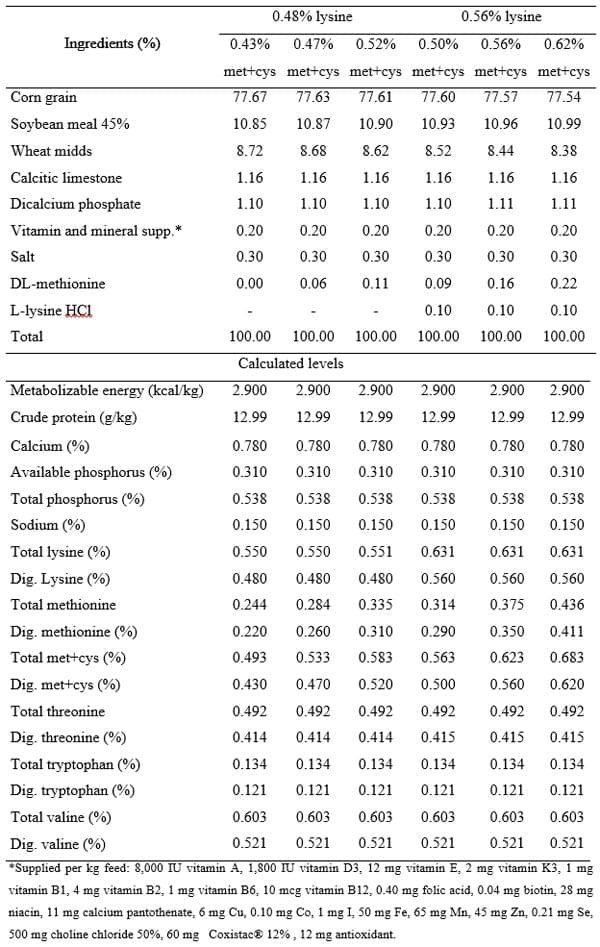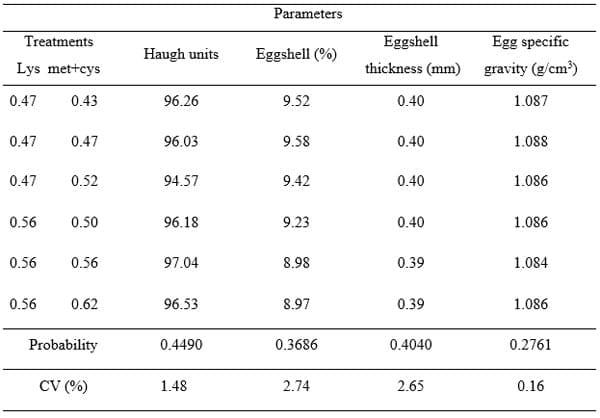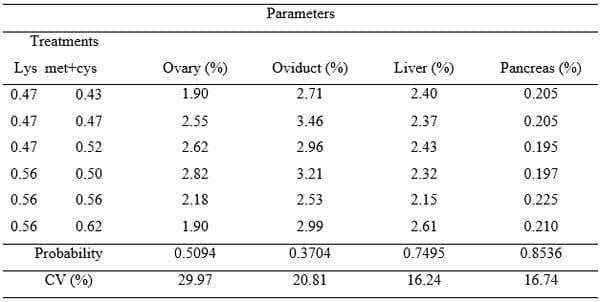Introduction
Modern layer strains have high genetic potential for egg production, and may produce eggs for more than one laying cycle by inducing molting. Forced molting is defined as a set of management practices that cause stress, inducing birds to stop producing eggs and the partial molting of the feathers (Roland & Brake, 1982). The objective of forced molting is to allow the reproductive system of layers to rest for some time in order to recover its production capacity and to increase the longevity of layers for further 25 to 30 weeks, as well as to improve egg quality, reducing losses caused by poor eggshell quality (Rodrigues, 2005).
Good egg production during the second laying cycle is only obtained when adequate nutrition is provided during the resting period to ensure the recovery of body components and rapid return to lay (Mendonça & Lima, 1999). One of the most important nutrients in this phase is protein, particularly sulfur amino acids. The optimal performance of laying hens demands protein supply based on the requirements of essential amino acids, which most important are lysine and methionine + cystine (Mendonça, 1996).
Lysine is used for the synthesis of egg and body protein, and any deficiency results in egg production losses (Hiramoto et al., 1990).
In addition, sulfur amino acid levels may influence internal egg quality parameters, such as Haugh units and albumen index (Bertechini et al., 1995; Narvaez-Solarte, 1996).
This study aimed at evaluating the effects of different dietary digestible lysine and methionine + cystine levels supplied during the post-molting period and second laying cycle on body recovery, performance, egg quality, and morphometrics of the reproductive system, liver, and pancreas of commercial layers.
Materials and Methods
The experimental period included the phases of molting (14 days), rest (28 days) and second laying cycle (four periods of 28 days each). Layers were selected according to body weight and egg production. In the trial, 432 commercial Isa Brown layers with 72 weeks of age were distributed, according to a completely randomized experimental design, into six treatments with nine replicates of eight birds each, totaling 54 experimental units.
Birds were offered water and feed ad libitum during the entire experimental period. During molting, a 12 hour light/day lighting program was adopted. During rest, light was increased 15 min/day until 17 hours/day were reached, and this was maintained during the second laying cycle.
Molt was induced by including 3,000 ppm zinc oxide in a diet, containing 0.43% calcium and 0.02% sodium, that was fed for 14 days.
During rest, the following digestible lysine and methionine + cystine levels were supplied (Table 1): 0.48% digestible lysine and 0.43% digestible methionine+cystine (90% amino acid ratio); 0.48% digestible lysine and 0.47% digestible methionine+cystine (100% amino acid ratio); 0.48% digestible lysine and 0.52% digestible methionine+cystine (110% amino acid ratio); 0.56% digestible lysine and 0.50% digestible methionine+cystine (90% amino acid ratio); 0.56% digestible lysine and 0.56% digestible methionine+cystine (100% amino acid ratio); 0.56% digestible lysine and 0.62% digestible methionine+cystine 110% amino acid ratio).
Table 1 - Ingredient and nutritional composition of the experimental diets supplied during the resting period.

During the second laying cycle, a diet based on corn and soybean meal was formulated according to the recommendations of Rostagno et al. (2005) with 17% crude protein, 4.2% calcium, and 0.23% sodium.
During molting, the following performance parameters were evaluated: feed intake, egg production, body weight loss, days until laying stopped, and livability.
During the resting period, the following performance parameters were evaluated: feed intake, egg production, days to return to lay (50 – 60% egg production), days to lay the first and the tenth egg, body weight recovery, feed conversion ratio (kg feed/dozen eggs), and livability [(total number of birds – number of dead birds during forced-molting)/total number of birds x 100).
During the second production cycle, the following performance parameters were evaluated at the end of each period: feed intake, egg production, feed conversion ratio (kg feed per kg eggs and per dozen eggs), average egg weight (total weight of eggs laid/number of eggs laid, per experimental unit), egg mass (egg production percentage x average egg weight). Egg quality was also evaluated as to: Haugh unit (100 log (h + 7.57 – 1.7 W 0.37), according to Brant et al. (1951), where: H = albumen height in mm, W = egg weight in g, eggshell percentage and thickness, and egg specific gravity. Egg specific gravity was determined immersing the eggs in NaCl solutions, which densities ranged between 1,065 and 1,100 g/cm3 at 0.005 gradients, as proposed by Moreng and Avens (1990).
At the end of the molting period and of the resting period, four birds per treatment were sacrificed by neck dislocation. Birds were previously fasted for eight hours and weighed immediately before sacrifice to allow subsequent calculation of relative ovary, oviduct, liver, and pancreas weights.
The obtained data were submitted to analysis of variance using the General Linear Model (GLM) procedure of SAS statistical package (SAS Institute, 2002). Means were compared by the test of Tukey at 5% probability level.
Results and Discussion
The layers submitted to forced molting by the supply of zinc oxide presented 35.51g/hen/day feed intake, 14.94% relative egg production, body weight loss of 14.60% on day 7 and 17.46% on day 14 of the molting period, 4.61 days until laying stopped, and 98.60% livability.
According to Baker et al. (1983), in order to obtain good performance during the second laying cycle, layers need to lose 25-30% of their body weight, allowing for ovary regression. In the present study, the method applied to induce molting resulted in lower body weight loss (17.46%). However, the dietary inclusion of zinc oxide to induce molting promotes adequate body weight loss and reduces mortality rates because feed is not withdrawn, thereby reducing bird stress.
During the post-molting period, feed intake significantly increased (p<0.05) when hens were fed the diet with 0.56% digestible lysine and 0.56% digestible methionine+cystine (daily intakes of 586.77 mg/hen/day of both digestible lysine and methionine+cystine), which, however, was statistically different from the feed intake of those fed 0.56% digestible lysine and 0.50% digestible methionine+cystine (daily intakes of 559.07 and 508.77 mg/hen/day digestible lysine and methionine+cystine, respectively; Table 2). The influence of lysine dietary level on feed intake may have been a response to the change in the diet amino acid profile when lysine level increased. According to Andriguetto et al. (2003), amino acid imbalance in a diet results in specific changes in blood amino acid levels, affecting appetite.
Table 2 – Mean, coefficient of variation (CV) and probability of performance parameter evaluated during the resting period.
These results are different from those obtained by Latshaw (1976) in a study to determine optimal lysine requirements for white layers. He supplemented a basal diet containing 0.57 lysine with 0, 0.05, 0.10, or 0.15% L-lysine, and did not observe any influence of these levels on egg production or feed intake; only egg weight was positively affected.
The findings obtained in the present study relative to methionine+cystine levels are consistent with those of Waldroup and Hellwing (1995), who observed lower feed intake in Leghorn hens fed lower methionine+cystine levels added to a basal diet based on corn and soybean meal.
Austic (1986) mentions that severe dietary methionine deficiency reduces methionine blood level, which signals the central nervous system to active the mechanisms responsible for feed intake reduction.
There was no influence of treatments on the other evaluated parameters (p>0.05).
During the second laying cycle, egg weight was significantly affected (p<0.05) by treatments (Table 3). Hens fed the diet with 0.56% digestible lysine (509.88 mg/hen/day) and 0.56% digestible methionine+cystine (509.88mg/hen/day) presented higher egg weight, which, however, was not significantly different from that obtained with hens fed the diet containing 0.56% digestible lysine (514.47 mg/hen/day) and 0.62% digestible methionine+cystine (569.59 mg/hen/day).
Table 3 – Mean, coefficient of variation (CV) and probability of performance parameter evaluated during the second laying cycle (average of the four evaluated periods).
The higher egg weight obtained with the diet containing 0.56% lysine and 0.56% methionine+cystine may be explained by the adequate supply of the amino acid requirements during the resting period. Although hens fed the diets containing lower lysine and methionine + cystine levels produced lighter eggs, the other parameters evaluated during the second laying cycle were not affected.
These results are consistent with those of Harms and Russell (2003), who observed that egg weight increased with increasing dietary methionine + cystine levels. Laurentiz et al. (2005) evaluated total sulfur amino acid levels for semi-heavy layers after forced molting and also found that the lowest TSAA level supplied (0.45%) after molting reduced egg weight relative to the other TSAA levels (0.60% and 0.75%).
However, the results of the present study are different from the findings of Schmidt et al. (2009), who did not find any influence of the supply of different digestible lysine levels (0.55, 0.60, 0.65, 0.70, and 0.75%) to layers during the second cycle egg production.
Silva et al. (2000) also fed different digestible lysine and sulfur amino acid levels to commercial layers and did not find any differences in performance parameters.
Lysine and methionine + cystine levels supplied during the post-molting period did not affect (p>0.05) internal or external quality parameters of the eggs produced during the second laying cycle (Table 4). Although 0.56% lysine and 0.56% methionine + cystine promoted higher egg weight, their eggshell quality was not affected.
Table 4 – Mean, coefficient of variation (CV) and probability of the egg quality parameters evaluated during the second laying cycle.
These results are consistent with those obtained by Shafer et al. (1996), who did not find any effect of increasing SAA levels on eggshell percentage or weight. Feeding 0.517, 0.569, 0.624, 0.679, or 0.734% digestible methionine + cystine to semi-heavy layers, Sá et al. (2007) also found no effect of SAA levels on egg quality.
On the other hand, Cupertino(2006) observed decreasing eggshell percentage as digestible methionine+cystine levels increased in the diet, as well as Carey et al. (1991). According to Harms et al. (1998), egg weight and eggshell quality present high negative correlation, and when dietary methionine+cystine levels promote an increase in egg weight, and there are no changes in eggshell deposition, eggshell quality is compromised. However, this effect was not observed in the present study.
After molting, relative organ weights were: 0.35% for the ovary, 1.21% for the oviduct, 1.77% for the liver, and 0.15% for the pancreas. Similar results were observed by Berryand Brake (1991), who compared fasting to the dietary supply of 2,000 ppm zinc oxide as forced-molting method until 30% weight loss, and 1.18% oviduct weight relative to live weight when zinc oxide was used. One of the most important factors of induced molting is body weight loss, resulting in follicle development arrest and atresia (Araújo et al. 2007), which will ensure optimal performance during the second laying cycle.
Relative organ weights evaluated when hens were sacrificed after the post-molting period were not influenced by the treatments (Table 5), showing that the amino acid levels supplied were sufficient to recover the weights of the reproductive organs, liver, and pancreas, thereby promoting good results during the second laying cycle.
Table 5 – Mean, coefficient of variation and probability of the evaluated organ relative weights obtained after the resting period.
Conclusions
Based on the results of the present study, it is recommended to supply 0.56% digestible lysine and 0.56% digestible methionine + cystine (daily intakes of 509.88 mg/hen/day) to commercial layers during the post-molting period, because these levels promote higher egg weight without affecting eggshell quality during the second laying cycle.
References
Andriguetto JM, PERLY Perly L, Minardi I, Germael A, Flemming GA, Filho ABS. Nutrição Animal, Editora Nobel, Volume 1 e 2, 2003.
Araújo CSS, Artoni SMB, Araújo LF, Junqueira OM, Barbosa LCGS,LimaCG. Morfometria do oviduto de poedeiras comerciais semipesadas submetidas a diferentes métodos de muda. Ciência Rural, Santa Maria, v. 37, n. 1, 2007.
Austic RE. Biochemical description of nutritional effects. In: FISHER, C.; BOORMAN, K.N. (Eds.) Nutrient requirements of poultry and nutritional research.London: Butterworths, 1986; 59-77.
Baker M, Brake J, Mc Daniel GR. The relationship between body weight loss during an induced molt and postmolt egg production, egg weight, and shell quality in caged layers. Poultry Science 1983; 62: 409–413.
Berry WD, Brake J. Induced molt increases eggshell quality and calbindin - D28k content of eggshell gland and duodenum of aging hens. Poultry Science 1991; 70:655-7.
Berry WD. A physiological comparison of methods for induced molting in the laying hen. Thesis ( M. S.)NorthCarolineStateUniversity,Raleigh, 1984.
Bertechini AG,TeixeiraAS, Lira VMC. Níveis de lisina para poedeiras comerciais leves na fase de pico de postura.. In: Conferência APINCO de ciência e tecnologia avícola, 1995; Curitiba, Paraná, Brasil. p. 75
Brant AW, Otte AW, Norris KH. Recommend standards for scoring and measuring opened egg quality. Food Technology 1951; 5: 356-361.
Carey JB, Asher RK, Angel JF. The influence of metionine intake on egg consumption. Poutry Science 1991; 70(1):152.
Cupertino ES. Exigência de aminoácidos digestíveis (lisina, aminoácidos sulfurosos e treonina) para poedeiras leves e semipesadas no período de54 a70 semanas de idade. [Dissertação]. Viçosa (MG): Universidade Federal de Viçosa; 2006.
Harms RH, Russel GB. Performance of Commercial Laying Hens Fed Diets with Various Levels of Methionine. Journal of Applied Poultry Research 2003; 12: 449-455.
Harms RH, Russel GB. The influence of methionine on commercial laying hens. Journal of Applied Poultry Research 1998; 7:45-52.
Hiramoto K, Muramatsu T, Okumura J. Effect of methionine and lysine deficiencies on protein synthesis in the liver and oviduct and in the whole body of laying hens. Poultry Science 1990; 69:84-89.
Latshaw JD. Lysine requeriment of hens fed diets with corn as major cereal grain. Poultry Science 1976; 55(6): 2348-2353.
Laurentiz AC, Filardi RS, Rodrigues EA, Junqueira O.M., Casartelli E.M, Ferreira Duarte K. Níveis de aminoácidos sulfurados totais para poedeiras semi-pesadas após a muda forçada. Ciência Rural, v.35, n.001, p.164-168, 2005.
Mendonça BP. Manejo alimentar de matrizes pesadas. In: Conferência APINCO de Ciência e Tecnologia Avícola, 1996; Curitiba, Paraná, Brasil. p. 77-90.
Mendonça Jr CX, Lima FR. Efeito dos níveis de proteína e de metionina da dieta sobre o desempenho de galinhas poedeiras após a muda forçada. Brazilian Jounal Veterinary Reserch Animal Science, v.36, n.6, 1999.
Narvaez-Solarte WV. Exigências em metionina+cistina para poedeiras leves e semipesadas. [Dissertação]. Viçosa (MG): Universidade Federal de Viçosa; 1996.
Rodrigues EA. Níveis de vitamina D3 e cálcio nas rações de pré-postura e postura e níveis de cálcio nas fases de muda e pós-muda sobre o desempenho de poedeiras comerciais. [Dissertação]. Jaboticabal (SP); Faculdade de Ciências Agrárias e Veterinárias -UNESP, 2005.
Roland DA, Brake JH. Influence of premolt production on postmolt performance with explanation for improvement in egg production due to force molting. Poultry Science, Champaing 1982; 61(12): 2473-2481.
Rostagno HS, Albino LFT, Donzele JL, Gomes PC, Oliveira RF, Lopes DC, Ferreira AS, Barreto SLT. Tabelas brasileiras para aves e suínos; composição de alimentos e exigências nutricionais. Viçosa (MG); UFV, 2ed, 186p, 2005.
Sá LM, Gomes PC, Albino LFT, Rostagno HS, Nacif CCC. Exigência nutricional de metionina + cistina digestível para galinhas poedeiras no período de34 a50 semanas de idade. Revista Brasileira de Zootecnia, v.36, p.1837-1836, 2007.
SAS INSTITUTE. SAS User’s Guide:Statistics. Cary, 466p, 2002.
Schmidt M, Gomes PC, Rostagno HS, Albino LFT, Nunes RV, Cupertino ES. Exigência nutricional de lisina digestível para poedeiras semipesadas no segundo ciclo de produção. Revista Brasileira de Zootecnia. vol.38, n.10, p. 1956-1961.
Shafer DJ, Carey JB, Prochaska JF. Effect of dietary methionine intake on egg component yield and composition. Poultry Science 1996; 75:1080–1085.
Silva JHV, Mukami F, Albino LFT. Uso de rações à base de aminoácidos digestíveis para poedeiras. Revista Brasileira de Zootecnia, Viçosa, MG, v.29, n.5, p. 1446-1451, 2000.
Waldroup PW, Hellwing HM. Methionine and total sulfuramino acid requirements influenced by stage of production. Journal of Applied Poultry Science 1995; 4:283-292.















